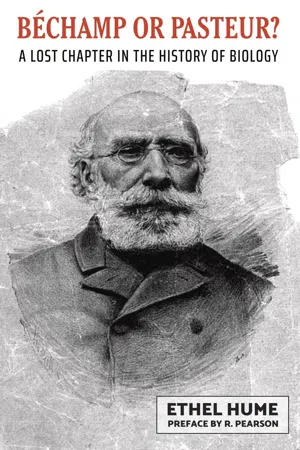
- English
- ePUB (mobile friendly)
- Available on iOS & Android
Bechamp or Pasteur?
About This Book
This volume contains new editions of two books.
R. Pearson's Pasteur, Plagiarist, Imposter, originally published in 1942, serves as the introduction. It details some of the reasons for the rancorous relationship between Louis Pasteur and Antoine Béchamp. Pearson points out many of the problems in Pasteur's work, and provides details, statistics and evidence to support his case. Some of the frauds which were eventually admitted by the Pasteur Institute are mentioned here.
Ethel Hume's Béchamp or Pasteur?, originally published in 1923, is the larger work, and provides the main body of evidence, in three parts:
1. The Mystery of Fermentation
2. The Microzymas
3. The Cult of the Microbe
This book is a compelling and thorough account of Pasteur's plagiarism and scientific fraud. It contains the evidence of the false grounds on which the germ theory of disease was elevated to its current status as a dogma, and beyond question. In this forgotten chapter of the history of biology and medicine, we are shown how powerful interests and agendas have prevailed over genuine science.Here are strong reminders of the powers which control the pharmaceutical and regulatory industries to this day.
Hume details the contention between Béchamp and Pasteur, and presents ample references to the original source material and supporting evidence. No claim is left undocumented or unsupported. Both authors are clearly not fans of Pasteur or his corruption of the principles of science, and they declare their intentions openly. They seek to undo a massive medical and scientific fraud. This new edition of their work is presented with the same intent.
The real facts, which have been suppressed for so long, should be revealed to the world. Modern science needs to return to this bifurcation point, and take the pleomorphic path. When this phenomenon is truly understood, many aspects of modern medical thought will disappear, as do all things which outlive their usefulness. In Béchamp's work, we can see on display the foundations of the quantum biology and epigenetics which inform the work of such modern researchers as Joe Dispenza, Gregg Braden, and Bruce Lipton.
This is a foundational text of the new biology, and should be required reading for anyone seeking to understand how the body actually functions and heals. This book should be read by every doctor, health professional, nutritionist, and biologist.
"Nothing is lost, nothing is created... everything is transformed. Nothing is the prey of death. Everything is the prey of life."
- Antoine Béchamp
CONTENTS
Pasteur: Plagiarist, Imposter / R. Pearson
Béchamp or Pasteur? / Ethel Hume
Part 1: The Mystery of Fermentation
A Babel of Theories / Pasteur's Memoirs of 1857 / Béchamp's 'Beacon Experiment' / Claims and Contradictions / The Soluble Ferment / Rival Theories and Worker
Frequently asked questions
Information
The Mystery of Fermentation
A Babel of Theories
BEFORE STARTING ANY EXAMINATION of the contributions of Béchamp and Pasteur to the scientific problems of their age, it may be well to consider the utter confusion of ideas then reigning in the scientific world in regard to the mysteries of life and death, and to the phenomenon of fermentation.
Table of contents
- Table of Contents
- Bechamp or Pasteur?
- Imprint
- About this book
- Antoine Bechamp
- Book One: Pasteur, Plagiarist, Imposter
- Author's note
- The Prior History of the ‘Germ Theory’
- Béchamp, Pasteur, and Fermentation
- Vinous Fermentation
- Béchamp’s Microzymas or ‘little bodies’
- Silkworm Disease: another steal!
- Pasteur also a Faker – Antisepsis
- Are Biologicals Injurious?
- Animal Serology: Anthrax
- Statistics
- Real Immunity
- Photographs
- Book Two: Bechamp or Pasteur?
- Author’s preface
- Introduction
- Part 1: The Mystery of Fermentation
- A Babel of Theories
- Pasteur’s Memoirs of 1857
- Béchamp’s ‘Beacon Experiment’
- Claims and Contradictions
- The Soluble Ferment
- Rival Theories and Workers
- Part 2: The Microzymas
- The ‘Little Bodies’
- Diseases of Silkworms
- Laboratory Experiments
- Nature’s Experiments
- A Plagiarism Frustrated
- Microzymas in General
- Modern Confirmations of Béchamp
- Part 3: The Cult of the Microbe
- The Origin of ‘Preventive Medicine’
- The International Medical Congress and some Pasteurian Fiascos
- Hydrophobia
- A Few Examples of the Cult in Theory and in Practice
- Some Lessons from World War I and a Few Reflections on World War II
- The Writing on the Wall
- Conclusion
- Also from A Distant Mirror